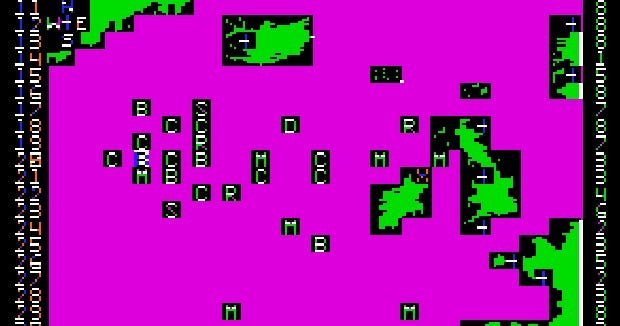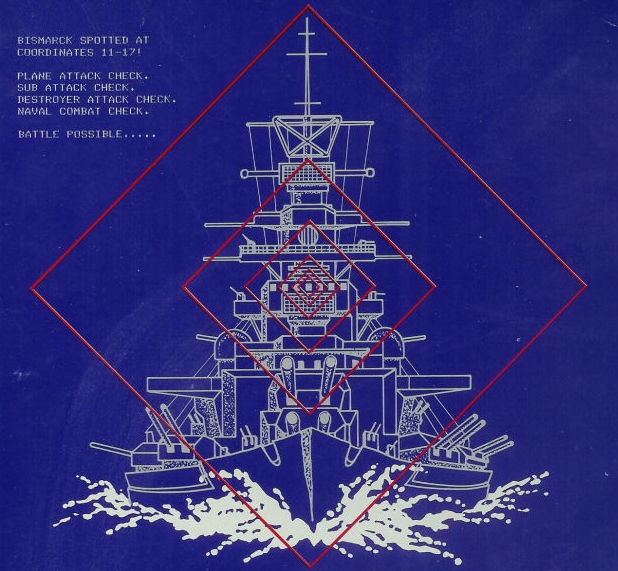The Flare Path: In The Denmark Strait
Remembering Computer Bismarck
The trick of using high prices to imply high quality goes back a very long way in digital wargame publishing. Computer Bismarck, the title that launched the genre in January 1980, was advertised as “the $2160 wargame” ($60 for the software, $2100 for the Apple II Plus necessary to run it). SSI proudly proclaimed their creation was “worth every cent” of this princely sum. Whether you ended up agreeing with them depended largely on how much you valued novelties like artificial opposition and effortless fog of war, and how ready you were to overlook design quirks like an onerous interface, an absence of alternative scenarios, and a monstrously magenta North Atlantic.
The often tense, sometimes tedious Computer Bismarck wouldn't have happened without the drive, design flair, and supportive family of a young business-minded wargamer called Joel Billings (recently interrogated over at A Wargamer's Needful Things), and the coding talent of a grog-turned-programmer called John Lyon.
Board wargame giants Avalon Hill also played a role, albeit an unacknowledged one. Rather than come up with their own blueprint from scratch, the naive/canny Californian ingénues opted to base their first release on something tried and tested, Avalon Hill's Bismarck. The decision eventually led to a 1984 legal action which Joel settled out of court with a $30,000 payment.
Borrowing heavily from an existing design may have been a mistake, but simulating Operation Rheinübung, the attempted Bismarck/Prinz Eugen breakout of 1941, was inspired. Choosing one of WW2's best known episodes allowed SSI to tap into a vast reservoir of pre-existing customer enthusiasm and knowledge. And forcing solitaire players to play as the (British) hounds in history's most exciting naval foxhunt, made John's AI coding task relatively simple.
Computer Bismarck is as asymmetrical as wargames get. On one side is 'Otto von Computer' attempting to sneak two of the Kriegsmarine's formidable floating fortresses into the Atlantic to raid Allied convoys, on the other is the player with their plethora of individually tracked and manoeuvred Royal Navy vessels and Coastal Command brine scourers, working hard to locate and neutralise the raiders. This is a contest without imposed or natural balance, without frontlines, and, rather refreshingly in the light of the hundreds of combat-fixated battle sims that followed it, without a great deal of battle.
Solo sea-lords spend the vast majority of a typical thirty-turn, 5-day game guessing, searching, typing and grumbling about filthy weather. One of CB's most elegant and important features is its meteorology-influenced spotting model. Every ship and aircraft has a detection capability stat and every square on the gridded map a prevailing weather state indicated by a number between 1 and 9. If, say, the units you've placed in 14,17 have a combined detection total of 6 and the weather is a stormy 7 there's a good chance any Axis ships traversing the square will slip past unnoticed. Fog and night phases add a little extra complexity to the equations but the fundamental straightforwardness of the system is never compromised.
Less pleasing and less plausible than the spotting system is the way SSI chose to alter weather as time passes. Clearly John Lyon or the 48K Apple II weren't quite up to modelling the motive subtleties of North Atlantic climate. Instead of dynamic Westerlies-driven pressure areas and sinuous fronts, we get horizontal stripes of identical conditions that march steadily southward (with, admittedly, a dash of random alteration) during the course of a game. A modern remake without a vastly improved weather engine would be pointless.
Evidence that the first commercial digital wargame is the work of serious grogs fascinated by their theme, is scattered throughout Computer Bismarck. It's there in the special 'shadowing' rules that give Allied ships and aircraft in the right place at the right time the chance of automatically keeping tabs on Kriegsmarine quarries. It's there in the reinforcement system that slowly swells the British order of battle (Force H arrive from the off-map Gibraltar relatively late in the game). It's there in the swarm of individually identified convoys that must be guided across a U-boat infested Pond to specific destinations like the Clyde, and in the carefully engineered victory points system that passes sage judgement on close-run contests.
The code isn't quite sophisticated enough to replicate aspects of the real operation like fuel leak following (After the initial clash with the Hood and the Prince of Wales, the Bismarck's oil trail made her easier to track) and the extraordinary escape of HMS Sheffield (Swordfish attacked the RN cruiser after mistaking it for their target. Only faulty torpedo detonators prevented a disaster.). However, the largely automated combat mechanics can leave vessels with reduced top speeds, disabled turrets, and holed oil tanks. There are times when you find yourself hurling a hopelessly outgunned cruiser or destroyer flotilla at a stumbled-upon German heavyweight in the desperate hope that the tactic will produce something akin to the mangled rudder that crippled the real Bismarck. Of course, every sacrificial lamb blasted out of the water by enemy 15 inchers increases the German VP tally.
Assessing Otto von Computer's IQ is bally hard thanks to the high tog fog of war. He's certainly sufficiently imaginative to vary his Atlantic approach avenues from game to game, but it's difficult to say how good he is at threat assessment, convoy hunting, and reading the game's semi-predictable weather patterns. Does he ever cheat by taking a look at Allied dispositions? Do his pathfinding routines ever struggle when close to crinkly coastlines? I've a hunch the answer to both questions is 'yes' but Joel and John are probably the only people who could say for sure.
One area in which this venerable genre pioneer is clearly vulnerable to criticism is in its control approach. Where, in Ed Williger's Computer Ambush (a title released a short time later) players can issue complicated orders which are then automatically implemented over multiple turns, in CB admirals are forced to move units in pigeon steps. Every turn, every ship and plane requires an appropriate typed compass direction (N, NE, E etc). Late-game when the board is increasingly crowded, manoeuvring dozens of units without a 'make-for-grid-square...' or a 'combine-into-task-force' function quickly becomes tiresome.
Modern digital wargamers wishing to examine at close quarters the genre's Wright Flyer, its Puffing Devil, may also struggle with the way Computer Bismarck provides information. For example, it's impossible to tell at a glance whether multiple units are sharing a single map cell (typing 'QN' followed by the relevant coordinates lists occupants) or if a particular square is fogbound (typing 'SN' - 'search now' reveals fog locations and the strength of your current search effort). When, in their advertising, SSI crowed that “without the drudgery or the organisational overhead of paper and pencil wargames, your mind is free to develop and test sophisticated search, combat and logistics strategies” they failed to mention that in some respects Computer Bismarck is actually fiddlier, more labour intensive, than quaint cardboard alternatives.
Can today's battle sim devs learn anything from the groundbreaking but flawed CB apart from the obvious ("Oceans should be blue-green rather than purple-pink")? I believe they can. With its emphasis on the hunt rather than the kill, and its enthusiastic embracing of asymmetry, Digital Wargame #1 has much to teach a genre dominated by predictable treatments of familiar themes.
^ Essentially accurate though the portrayal of Lütjens as a stereotypical Nazi is unfortunate.
* * * *











